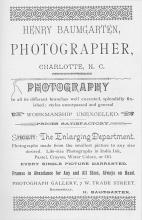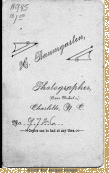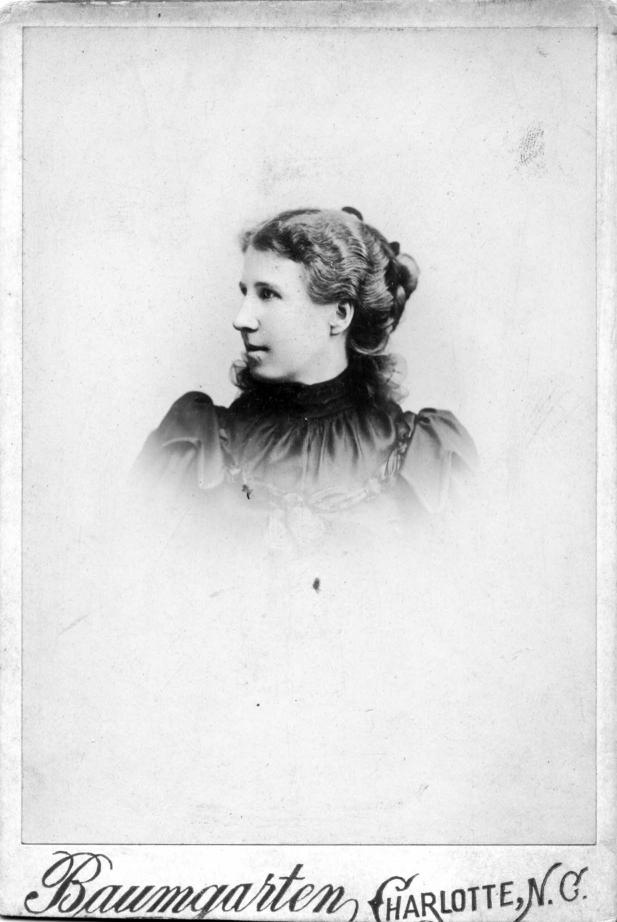You are here
Henry Baumgarten (1839 -1918)
Henry Baumgarten was born on March 12, 1839 in what is now the province of Hanover, Germany. Baumgarten’s father Selig, mother Winzee [sic] and their seven children immigrated to the United States, settling in Baltimore, Maryland in 1852. Selig Baumgarten was an engraver, and Henry served an apprenticeship to an engraver. This was ideal preparation for his future occupation. (1) There are reports that he fought in the Civil War on the side of the Confederacy in Louisiana. However, other than his obituary, there is no primary evidence supporting Baumgarten’s claim to military service. (2)
In 1872, Baumgarten and Broadaway became entangled in a lawsuit that dragged on for a number of years. Apparently, Baumgarten bought out Broadaway's business with a stipulation that Broadaway not open another studio in Charlotte for ten years. It soon became obvious that Broadaway never meant to keep this part of the agreement, and Baumgarten filed suit. Shortly after the case went to trial, an injunction was issued preventing Broadaway from offering his photography services in Charlotte. The matter eventually made its way to the North Carolina Supreme Court which ruled in favor of Baumgarten. (3) By 1880, Broadaway was living with his family and working as a photographer in Greenville, South Carolina. (4)
According to his obituary, Henry Baumgarten was living in Mecklenburg County by 1867. In his shop above Nisbett’s store at 7 West Trade Street, Baumgarten captured the faces of Charlotteans both black and white, gentile and Jew. (5) Apparently his photography business was not always lucrative because in addition to running a studio in 1880, Baumgarten owned a saloon and billiards establishment at 4 West Trade Street. (6) In 1875, his brother Aldolphe left his studio in Winnsboro, South Carolina and joined his brother in Charlotte as a photographer. (7) By 1884, another brother, Moses Baumgarten worked with him in the studio, but he later became a bookkeeper with The Charlotte Daily News. (8) Henry Baumgarten was a family man, having married Bertha Kohn (1838-1918) of Bavaria in Baltimore. (Newspaper accounts list her maiden name as Furth or Furst. (9) Together, they had two sons and two daughters. (10) His daughter Blanche Baumgarten Weill assisted her father in the studio by hand tinting photographs, a precursor to color film. He is also remembered as a devout Jew who played an instrumental roll in the development of Charlotte’s Jewish institutions and organizations. Baumgarten was one of the original trustees of the Hebrew Benevolent Society, which formed in 1872 and he served as President of Temple Shaaray Israel for twenty years. Only his wife survived him when he died on April 8, 1918. (11) Nine days later, his wife, Bertha Baumgarten, passed away. (12)
Albumem Print on Cabinet Card by Henry Baumgarten of Dr. Annie Alexander shortly after her graduation in medical school in 1886. She was the first female physician in North Carolina
The reverse side of a carte de visite that identifies the photographer is referred to as a backmark. This backmark proves the carte de visite was made by Baumgarten and gives the location of his studio.
To see more photographers in this exhibit, click on "Charlotte Photographers."
- Eighth Census, 1860, Population Schedule, Baltimore County, Maryland, p. 143.
- Charlotte Observer, 8 April 1918, Sec. 1, p. 5.
- North Carolina Supreme, Court, 77:8, Baumgarten v. Broadaway, 8 June 1877, p. 77 and Stephen Massengill, Photographers in North Carolina: The First Century, 1842-1941, pgs. 46-47.
- Eleventh Census, 1880, Population Schedule, Greenville County, Greenville, South Carolina, ED 80, p. 22.) Advertisement from Charlotte City Directory, 1889-1890, p. 24.
- The Charlotte Observer, 8 April 1918, Sec. 1, p. 5 and Beasley & Emerson’s Charlotte Directory, 1875, p. 111.
- Charles Emerson & Company, Charlotte City Directory, 1879-1880, p. 43.
- Harvey S. Teal, Partners with the Sun: South Carolina Photographers, 2002, p. 163.
- Turner’s Charlotte, North Carolina City Directory, 1889, p. 32.
- The Charlotte Observer, 8 April 1918, Sec. 1, p. 5. and The Charlotte News, 16 April 1918, p. 2.
- Thirteenth Census, 1910, Population Schedule, Mecklenburg County, North Carolina, ED 101, p. 165.
- Morris Speizman, The Jews of Charlotte, 1978, pp. 5-8 and The Charlotte Observer 8 April 1918, Sec. 1, p. 5.
- TheCharlotte News, 16 April 1918, p. 2 and Hebrew Cemetery Records, Robinson-Spangler Carolina Room, Public Library of Charlotte and Mecklenburg County, North Carolina.
Albumen paper was introduced in 1855. It was popular in the United States from 1860 to 1890. Albumen is literally a coating of egg whites that contains sodium chloride and provides a luster to the surface of the photograph. After the albumen was applied to the surface of thin, smoothed-surface paper, silver nitrate was applied to react with the sodium chloride. This process formed a light-sensitive silver chloride. Photographers usually purchased the paper already treated. During the course of the popularity of albumen paper, millions of eggs were used annually in its production.
Cabinet Card is an albumen print mounted on a 4 ½ x 6 ½ piece of cardboard.
Carte de visite is an albumen print mounted on a 4 ¼ x 2 ½ piece of cardboard.


